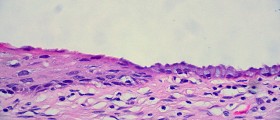
Menstrual cycle and the main phases
Menstrual cycle includes changes that take place in theinner genitalia in women between two menstruations. In most of the women,menstrual cycle lasts for 28 days. The entire cycle is controlled and overlooked bythe hormones of frontal part of the hypophysis and ovarian hormones, which arecreated in ovaries due to the influence of the hypophysis. Thanks to thehormone gonadotropin, functions of the ovaries are intensified and productionof ovarian hormones estrogen and progesterone starts. There are four main phases in menstrual cycle, ovarian,endometrial, cervical, and vaginal.
In ovarian phase, due to the influence ofreleasing factors, FS hormone is produced in hypophysis and this hormone stimulates the growth of egg cells. Only one of those eggs will turn into DeGraaf follicle that will enter the process of ovulation and in that moment, the outer membrane of De Graph follicle will burst, while the egg cell will go to tube uterine.Endometrial phase includes changes that happen in the wallsof uterus. It has its own 4 phases and those are proliferation, secretion,menstruation and regeneration. Proliferation and secretion are actually the preparation for the implantation of embryo in case fertilization happens. If not,endometrial layers are destroyed and menstruation occurs, followed by regeneration.Cervical phases include changes that happen on the cervix.Before the ovulation cervical fluid is thick, non elastic and completely closes thecervical channel, which does not allow spermatozoids to pass easily. After the ovulation, cervical fluid becomes clear, much less dense, thus allowingspermatozoid to move freely.Vaginal phase is all about changes that happen invaginal area.Causes of painful menstrual periods
Menstrual periods can be painful and that condition iscalled dysmenorrhea. Some women never have such problems, but there are also those that really suffer each month. Painthat emerges spreads over lower abdomen and lumbar area and can be followedby the overall bad condition, headache, nauseas, irritability, etc.Dysmenorrhea can be primary and secondary. In cases of primary type, gynecological examinationcannot reveal the cause of the painful menstrual periods, but when it comes to the secondary type, there are changes in uterus and ovaries. Pathological changesthat occur include inflammation, tumors and adhesions, and all of this leads to painfulmenstrual issues. Primary type usually affects younger women.
Firstmenstruations in young women are painless, but they can become nuisance afteronly couple of months. This is explained by the fact that first menstrual cyclesin women do not include ovulation, thus, no pain is present. Secondary dysmenorrhea happens in the cases where varioustumors exist (tumor in uterus, ovaries, tube uterine), though some kind of an inflammation can also be the cause of this medical problem. In order to eliminate the menstrual pain, all these causeshave to be examined and treated effectively and properly.
















Your thoughts on this
Loading...